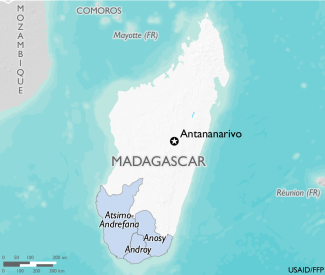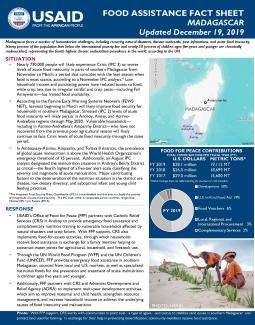December 19, 2019
Madagascar faces a number of humanitarian challenges, including recurring natural disasters, disease outbreaks, pest infestations, and acute food insecurity. Ninety percent of the population lives below the international poverty line and nearly 50 percent of children ages five years and younger are chronically malnourished, representing the fourth highest chronic malnutrition prevalence in the world, according to the UN.
Situation
- Nearly 730,000 people will likely experience Crisis (IPC 3) or worse levels of acute food insecurity in parts of southern Madagascar from November to March, a period that coincides with the lean season when food is most scarce, according to a November IPC analysis.* Low household income and purchasing power have reduced access to food, while crop loss due to irregular rainfall and crop pests—including Fall Armyworm—has limited food availability.
- According to the Famine Early Warning Systems Network, harvests beginning in March will likely improve food security for households in southern Madagascar; Stressed (IPC 2) levels of acute food insecurity will likely persist in Androy, Anosy, and Atsimo-Andrefana regions through May 2020. Vulnerable households—including in Atsimo-Andrefana’s Ampanihy District—who have not recovered from the previous poor agricultural season will likely continue to face Crisis levels of acute food insecurity through the same period.
- In Amboasary-Atsimo, Ampanihy, and Toliara II districts, the prevalence of global acute malnutrition is above the World Health Organization’s emergency threshold of 15 percent. Additionally, an August IPC analysis designated the malnutrition situation in Androy’s Bekily District as critical—the fourth highest of a five-tier alert scale classifying the severity and magnitude of acute malnutrition. Major contributing factors to the deterioration of the nutrition situation in the district are disease, low dietary diversity, and suboptimal infant and young child feeding practices.
*The Integrated Food Security Phase Classification (IPC) is a standardized tool that aims to classify the severity and magnitude of food insecurity. The IPC scale, which is comparable across countries, ranges from Minimal (IPC 1) to Famine (IPC 5).
Response
- USAID’s Office of Food for Peace (FFP) partners with Catholic Relief Services (CRS) in Androy to provide emergency food assistance and complementary nutrition training to vulnerable households affected by natural disasters and crop failure. With FFP support, CRS also implements food-for-assets activities, through which households receive food assistance in exchange for a family member helping to construct water points for agricultural, household, and livestock use.
- Through the UN World Food Program (WFP) and the UN Children’s Fund (UNICEF), FFP provides emergency food assistance in southern Madagascar, sourced from local and U.S. markets, as well as specialized nutritious foods for the prevention and treatment of acute malnutrition in children ages five years and younger.
- Additionally, FFP partners with CRS and Adventist Development and Relief Agency (ADRA) to implement multi-year development activities, which aim to improve maternal and child health, strengthen resource management, and increase household income to address the underlying causes of food insecurity and malnutrition.
Food for Peace Contributions
Total Contributions:
| U.S. Dollars | Metric Tons | |
|---|---|---|
| Fiscal Year 2019 | $38.1 million | 19,115 MT |
| Fiscal Year 2018 | $26.0 million | 18,699 MT |
| Fiscal Year 2017 | $29.0 million | 15,600 MT |
Country Specific Guidance


